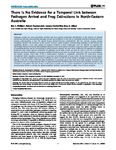There is no evidence for a temporal link between pathogen arrival and frog extinctions in north-eastern Australia
| dc.contributor.author | Phillips, BL | |
| dc.contributor.author | Puschendorf, R | |
| dc.contributor.author | VanDerWal, J | |
| dc.contributor.author | Alford, RA | |
| dc.date.accessioned | 2020-08-24T12:03:45Z | |
| dc.date.available | 2020-08-24T12:03:45Z | |
| dc.date.issued | 2012 | |
| dc.identifier.issn | 1932-6203 | |
| dc.identifier.issn | 1932-6203 | |
| dc.identifier.other | 12 | |
| dc.identifier.uri | http://hdl.handle.net/10026.1/16186 | |
| dc.description.abstract |
Pathogen spread can cause population declines and even species extinctions. Nonetheless, in the absence of tailored monitoring schemes, documenting pathogen spread can be difficult. In the case of worldwide amphibian declines the best present understanding is that the chytrid fungus Batrachochytrium dendrobatidis (Bd) has recently spread, causing amphibian declines and extinction in the process. However, good evidence demonstrating pathogen arrival followed by amphibian decline is rare, and analysis of putative evidence is often inadequate. Here we attempt to examine the relationship between Bd arrival and amphibian decline across north-eastern Australia, using sites where a wave-like pattern of amphibian decline was first noticed and at which intensive research has since been conducted. We develop an analytical framework that allows rigorous estimation of pathogen arrival date, which can then be used to test for a correlation between the time of pathogen arrival and amphibian decline across sites. Our results show that, with the current dataset, the earliest possible arrival date of Bd in north-eastern Australia is completely unresolved; Bd could have arrived immediately before sampling commenced or may have arrived thousands of years earlier, the present data simply cannot say. The currently available data are thus insufficient to assess the link between timing of pathogen arrival and population decline in this part of the world. This data insufficiency is surprising given that there have been decades of research on chytridiomycosis in Australia and that there is a general belief that the link between Bd arrival and population decline is well resolved in this region. The lack of data on Bd arrival currently acts as a major impediment to determining the role of environmental factors in driving the global amphibian declines, and should be a major focus of future research. | |
| dc.format.extent | e52502-e52502 | |
| dc.format.medium | Print-Electronic | |
| dc.language | en | |
| dc.language.iso | en | |
| dc.publisher | Public Library of Science | |
| dc.subject | Animals | |
| dc.subject | Anura | |
| dc.subject | Chytridiomycota | |
| dc.subject | Extinction, Biological | |
| dc.subject | Queensland | |
| dc.subject | Time Factors | |
| dc.title | There is no evidence for a temporal link between pathogen arrival and frog extinctions in north-eastern Australia | |
| dc.type | journal-article | |
| dc.type | article | |
| plymouth.author-url | https://www.ncbi.nlm.nih.gov/pubmed/23300687 | |
| plymouth.issue | 12 | |
| plymouth.volume | 7 | |
| plymouth.publication-status | Published online | |
| plymouth.journal | PloS one | |
| dc.identifier.doi | 10.1371/journal.pone.0052502 | |
| plymouth.organisational-group | /Plymouth | |
| plymouth.organisational-group | /Plymouth/Faculty of Science and Engineering | |
| plymouth.organisational-group | /Plymouth/Faculty of Science and Engineering/School of Biological and Marine Sciences | |
| plymouth.organisational-group | /Plymouth/REF 2021 Researchers by UoA | |
| plymouth.organisational-group | /Plymouth/REF 2021 Researchers by UoA/UoA06 Agriculture, Veterinary and Food Science | |
| plymouth.organisational-group | /Plymouth/Users by role | |
| plymouth.organisational-group | /Plymouth/Users by role/Academics | |
| dc.publisher.place | United States | |
| dcterms.dateAccepted | 2012-11-19 | |
| dc.identifier.eissn | 1932-6203 | |
| dc.rights.embargoperiod | Not known | |
| rioxxterms.versionofrecord | 10.1371/journal.pone.0052502 | |
| rioxxterms.licenseref.uri | http://www.rioxx.net/licenses/all-rights-reserved | |
| rioxxterms.type | Journal Article/Review |


